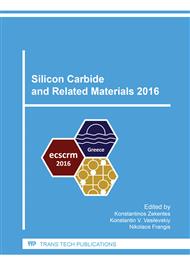p.622
p.626
p.630
p.634
p.638
p.642
p.649
p.655
p.661
Chemical Stability of Si-SiC Nanostructures under Physiological Conditions
Abstract:
The fast and direct detection of small quantities of biological and chemical species is of key importance for numerous biomedical applications. Extensive research has been conducted on nanoelectronic devices that can perform such detection with high sensitivity using silicon nanowires and nanostructures. However, it was recently demonstrated that Si material suffers a lack of long-term stability in physiological environments at nanometer scale [1,2], and is hence not suited for in situ sensing of biological molecules. The results presented here are two important steps toward the realization of core-shell Si-SiC NWFETs for the detection of biomolecules in liquid media. First, we show that SiC NWs exhibit higher chemical stability than Si NWs under physiological conditions. Second, we present the successful carburation of a thin film of Si resulting in a 3.6 nm thin SiC layer.
Info:
Periodical:
Pages:
638-641
Citation:
Online since:
May 2017
Keywords:
Price:
Сopyright:
© 2017 Trans Tech Publications Ltd. All Rights Reserved
Share:
Citation:


